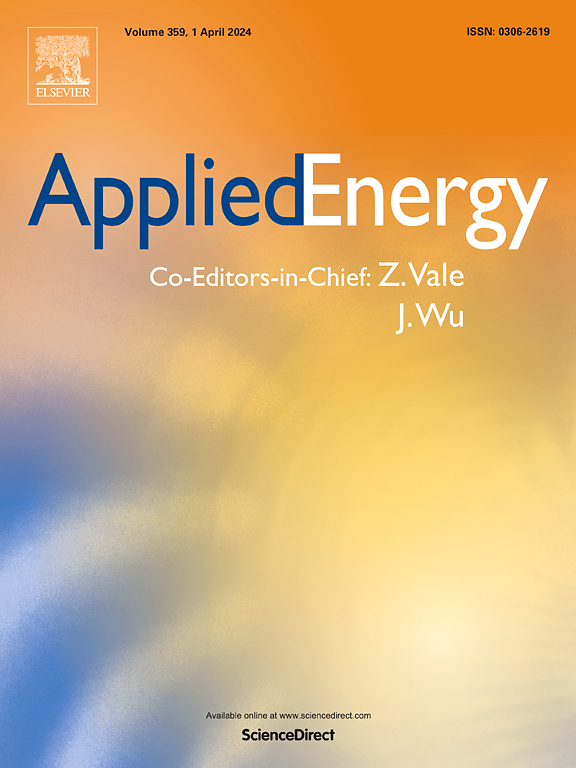A Li-O2 battery model coupled with LiO2 and Li2O2 reveals regulation mechanism of deposited product composition on mass transport and electron transfer
IF 11
1区 工程技术
Q1 ENERGY & FUELS
引用次数: 0
Abstract
To elucidate the regulation mechanism of deposited product composition on the coupling process of mass transport and electron transfer in lithium‑oxygen (Li-O2) batteries, a novel multi-step discharge/charge model with solid lithium superoxide (LiO2(s)) and lithium peroxide (Li2O2) as hybrid precipitation is proposed. This model couples the dynamic competitive growth mechanisms between LiO2(s) and Li2O2, while incorporating the asymmetric deposition and decomposition behaviors of Li2O2. The electrode surface passivation caused by the sluggish kinetic rate of electron across the Li2O2 film is solely responsible for the deep discharge termination based on the reduced graphene oxide cathode. LiO2(s) dominates the precipitation products with a limited capacity and a continuous decline in the LiO2(s) percentage with discharge depth. Although promoting the LiO2(s) formation is conducive to alleviating the electrode surface passivation, it aggravates the O2 transport resistance due to occupying more electrode pores with the same charge contribution. Hence the discharge capacity demonstrates a three-stage variation with increasing lithium superoxide (LiO2) formation rate, which rapidly grows by more than two times in stage 2 benefiting from the increased LiO2(s) percentage and enhanced solution mechanism. Whereas a slow rise of 32 % in the discharge capacity in stage 3 is attributed to the conversion of LiO2(s) to Li2O2 toroid for the discharge process controlled by O2 transport. An increase in the thickness or specific surface area of the cathode improves the discharge capacity mainly by facilitating the production of Li2O2 toroid despite the decrease in the LiO2(s) percentage, which is different from the regulatory mechanism of electrode porosity for accelerating the LiO2(s) formation. Increasing LiO₂ solubility predominantly mitigates the electrode surface passivation through enhancement of the solution pathway, whereas the elevated O₂ solubility synergistically facilitates the co-formation of LiO₂(s) and Li2O2 toroid. In addition, the LiO2(s) percentage declines for the amorphous Li2O2 film with low resistance and the electrode surface passivation mainly originates from the coverage of reactive sites by Li2O2.
用LiO2和Li2O2耦合的锂氧电池模型揭示了沉积产物组成对质量传递和电子转移的调控机制
为了阐明沉积产物组成对锂氧(Li-O2)电池中质量传递和电子转移耦合过程的调控机制,提出了固体超氧化物锂(LiO2(s))和过氧化锂(Li2O2)作为杂化沉淀的多步放电/充电模型。该模型将LiO2(s)和Li2O2之间的动态竞争生长机制耦合在一起,同时考虑了Li2O2的不对称沉积和分解行为。电子在Li2O2薄膜上缓慢的运动速率导致的电极表面钝化是基于还原氧化石墨烯阴极的深度放电终止的唯一原因。降水产物以LiO2(s)为主,容量有限,且随放电深度的增加,LiO2(s)百分比持续下降。虽然促进LiO2(s)的形成有利于缓解电极表面钝化,但由于在相同电荷贡献的情况下占据了更多的电极孔,从而加剧了O2的传输阻力。因此,放电容量随LiO2形成速率的增加呈现出三个阶段的变化,在第2阶段,由于LiO2(s)百分比的增加和溶液机制的增强,放电容量快速增长两倍以上。而第三阶段的放电容量缓慢上升了32%,这是由于在O2输运控制的放电过程中,LiO2(s)转化为Li2O2环状体。阴极厚度或比表面积的增加主要通过促进Li2O2环体的生成来提高放电容量,尽管LiO2(s)的百分比会降低,这与电极孔隙率加速LiO2(s)形成的调节机制不同。增加的LiO 2溶解度主要通过增强溶液途径减轻电极表面钝化,而提高的O2溶解度则协同促进了LiO 2和Li2O2环状物的共形成。此外,低电阻非晶Li2O2膜的LiO2(s)百分比下降,电极表面钝化主要源于Li2O2覆盖了反应位点。
本文章由计算机程序翻译,如有差异,请以英文原文为准。
求助全文
约1分钟内获得全文
求助全文
来源期刊

Applied Energy
工程技术-工程:化工
CiteScore
21.20
自引率
10.70%
发文量
1830
审稿时长
41 days
期刊介绍:
Applied Energy serves as a platform for sharing innovations, research, development, and demonstrations in energy conversion, conservation, and sustainable energy systems. The journal covers topics such as optimal energy resource use, environmental pollutant mitigation, and energy process analysis. It welcomes original papers, review articles, technical notes, and letters to the editor. Authors are encouraged to submit manuscripts that bridge the gap between research, development, and implementation. The journal addresses a wide spectrum of topics, including fossil and renewable energy technologies, energy economics, and environmental impacts. Applied Energy also explores modeling and forecasting, conservation strategies, and the social and economic implications of energy policies, including climate change mitigation. It is complemented by the open-access journal Advances in Applied Energy.
 求助内容:
求助内容: 应助结果提醒方式:
应助结果提醒方式:


